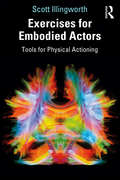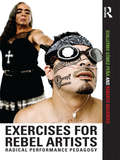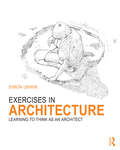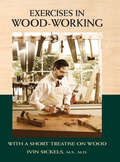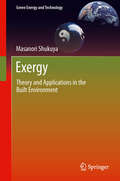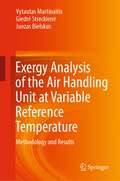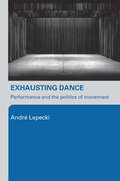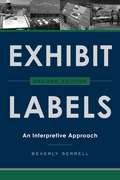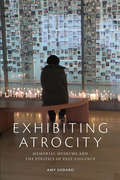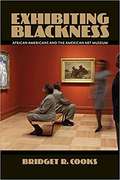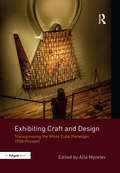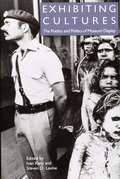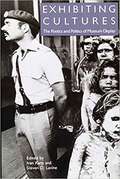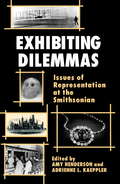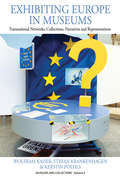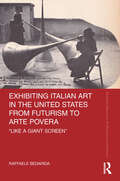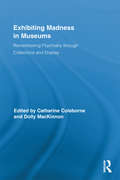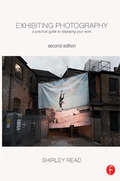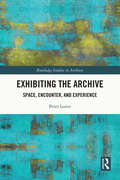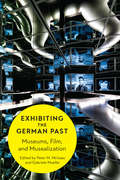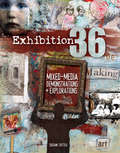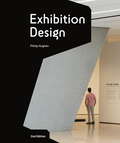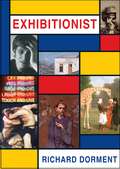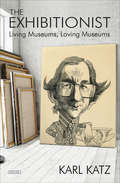- Table View
- List View
Exercises for Embodied Actors: Tools for Physical Actioning
by Scott IllingworthExercises for Embodied Actors: Tools for Physical Actioning builds on the vocabulary of simple action verbs to generate an entire set of practical tools from first read to performance that harnesses modern knowledge about the integration of the mind and the rest of the body. Including over 50 innovative exercises, the book leads actors through a rigorous examination of their own habits, links those discoveries to creating characters, and offers dozens of exercises to explore in classrooms and with ensembles. The result is a modern toolkit that empowers actors to start from their own unique selves and delivers specific techniques to apply on stage and in front of the camera. This step-by-step guide can be used by actors working individually or by teachers crafting the arc of a course, ensuring that students explore in physically engaged and dynamic ways at every step of their process.
Exercises for Rebel Artists: Radical Performance Pedagogy
by Guillermo Gómez Peña Roberto SifuentesIn Exercises for Rebel Artists, Guillermo Gomez-Pena and Roberto Sifuentes use their extensive teaching and performance experience with La Pocha Nostra to help students and practitioners to create ‘border art’. Designed to take readers right into the heart of radical performance, the authors use a series of crucial practical exercises, honed in workshops worldwide, to help create challenging theatre which transcends the boundaries of nation, gender, and racial identity. The book features: Detailed exercises for using Pocha Nostra methods in workshops Inspirational approaches for anyone creating, producing or teaching radical performance A step-by-step guide for large-scale group performance New, unpublished photos of the Pocha Nostra method in practice Exercises for Rebel Artists advocates teaching as an important form of activism and as an extension of the performance aesthetic. It is an essential text for anyone who wants to learn how use performance to both challenge and change.
Exercises in Architecture: Learning to Think as an Architect
by Simon UnwinArchitecture is a doing word. You can learn a great deal about the workings of architecture through analysing examples but a fuller understanding of its powers and potential comes through practice, by trying to do it... This book offers student architects a series of exercises that will develop their capacity for doing architecture. Exercises in Architecture builds on and supplements the methodology for architectural analysis presented in the author’s previous book Analysing Architecture (third edition, Routledge, 2009) and demonstrated in his Twenty Buildings Every Architect Should Understand (Routledge, 2010). The three books taken together deal with the three aspects of learning: description, analysis of examples, and practice. The book offers twelve exercises, each divided into a short series of tasks aimed at developing a particular theme or area of architectural capacity. The exercises deal with themes such as place-making, learning through drawing, framing, light, , uses of geometry, stage setting, eliciting emotional responses, the genetics of detail and so forth.
Exercises in Wood-Working: With a Short Treatise on Wood
by Ivin SickelsPut the Past to Work in Your Shop First printed in 1889, this book was written to educate college students in the craft and business of woodworking. Here, the original text is reprinted in its entirety, not only to help you discover late 19th-century practices in woodworking, but to help you make the most of traditional hand tools in the modern shop. As you work through a series of 39 exercises, you'll discover how to: Set up your shop and identify the tools every well-stocked hand-tool shop needs Effectively wield the most-used woodworking hand tools Use the various marketing gauges like a professional cabinetmaker Sharpen your tools - from plane blades to saw teeth Mark and cut the most-used joints in furniture making Use a frame saw (the quiet answer to the modern band saw) Make a door and drawer Install cabinet hardware including hinges and locks And more Plus, there are chapters on home building and repair of wooden fixtures, basic boat building, wood and traditional woodworking trades and more.
Exergy
by Masanori ShukuyaMany people, professionals and non-professionals alike, recognize that it is of critical importance to solve global energy and environmental issues. For this purpose, it is essential to have a scientific understanding of what is meant by the "energy" issue is and the "environmental" issue. The concept of "exergy" is a scientific concept that exactly fits. The concept of 'energy' is a scientifically-well established concept, namely 'to be conserved'. Then the question is what is really consumed. Exergy: Theory and Applications in the Built Environment is dedicated to answer this fundamental question by discussing the theory of "exergy" and by demonstrating its use extensively to describe a variety of systems in particular for built-environmental conditioning. Our immediate environmental space works within the flow of energy and matter in an "exergy-entropy" process, and the built environment can be designed with these energy & environmental issues in mind. Exergy: Theory and Applications in the Built Environment introduces readers who are not familiar with thermodynamics to the concept of exergy with a variety of discussion on the built-environmental space such as heating, cooling, lighting, and others. Readers, including students, researchers, planners, architects and engineers, will obtain a better picture of a sustainable built-environment.
Exergy Analysis of the Air Handling Unit at Variable Reference Temperature: Methodology and Results
by Vytautas Martinaitis Giedrė Streckienė Juozas BielskusThis book explore how exergy analysis can be an important tool for assessing the sustainability of buildings.Building's account or around 40 percent of total energy conditions depending on local climatic conditions. Due to its nature, exergy analysis should become a valuable tool for the assessment of building sustainability, first of all considering their scope and the dependence of their energy demands on the local environmental and climatic conditions.Nonetheless, methodological bottlenecks do exist and a solution to some of them is proposed in this monograph. First and foremost, there is the still-missing thermodynamically viable method to apply the variable reference environment temperature in exergy analysis. The monograph demonstrates that a correct approach to the directions of heat exergy flows, when the reference temperature is considered variable, allows reflecting the specifics of energy transformation processes in heating, ventilation, and air conditioning systems in a thermodynamically viable way. The outcome of the case analysis, which involved coordinated application of methodologies based on the Carnot factor and coenthalpies, was exergy analysis indicators – exergy efficiency and exergy destroyed – obtained for air handling units and their components. These methods can be used for the purposes of analysing and improving building technical systems that, as a rule, operate at a variable environment temperature. Exergy analysis becomes more reliable in designing dynamic models of such systems and their exergy-based control algorithms. This would improve the possibility to deploy them in building information modelling (BIM) technologies and the application of life cycle analysis (LCA) principles in designing buildings, thus improving the quality of the decision-making process. Furthermore, this would benefit other systems where variable reference environment plays a key role.This book is relevant to academics, students and researchers in the field of thermodynamic analysis considering HVAC equipment, building energy systems, energy efficiency, sustainable development of technical systems of energy, mechanics, and construction, as well as preservation of natural resources. Planners, designers, engineers of HVAC equipment, building energy systems, and developers of appropriate simulation tools (e.g., BIM) will also find it of use.
Exhausting Dance: Performance and the Politics of Movement
by Andre LepeckiThe only scholarly book in English dedicated to recent European contemporary dance, Exhausting Dance: Performance and the Politics of Movement examines the work of key contemporary choreographers who have transformed the dance scene since the early 1990s in Europe and the US. Through their vivid and explicit dialogue with performance art, visual arts and critical theory from the past thirty years, this new generation of choreographers challenge our understanding of dance by exhausting the concept of movement. Their work demands to be read as performed extensions of the radical politics implied in performance art, in post-structuralist and critical theory, in post-colonial theory, and in critical race studies. In this far-ranging and exceptional study, Andre Lepecki brilliantly analyzes the work of the choreographers: * Jerome Bel (France)* Juan Dominguez (Spain)* Trisha Brown (US)* La Ribot (Spain)* Xavier Le Roy (France-Germany)* Vera Mantero (Portugal) and visual and performance artists: * Bruce Nauman (US) * William Pope.L (US). This book offers a significant and radical revision of the way we think about dance, arguing for the necessity of a renewed engagement between dance studies and experimental artistic and philosophical practices.
Exhibit Labels: An Interpretive Approach
by Beverly SerrellBeverly Serrell presents the reader with excellent guidelines on the process of exhibit label planning, writing, design, and production. One of the museum field s leading consultants and label writers, Serrell has expanded upon her earlier book, Making Exhibit Labels, which has been a standard in the field since its initial publication. Exhibit Labels provides ample information on the art of label writing for diverse audiences, and explores the theoretical and interpretive considerations of placing labels within an exhibition. An examination of the impact of technological advances on the label-making process is also included. Exhibit Labels is a vital reference tool for all museum professionals.
Exhibiting Atrocity: Memorial Museums and the Politics of Past Violence
by Amy SodaroToday, nearly any group or nation with violence in its past has constructed or is planning a memorial museum as a mechanism for confronting past trauma, often together with truth commissions, trials, and/or other symbolic or material reparations. Exhibiting Atrocity documents the emergence of the memorial museum as a new cultural form of commemoration, and analyzes its use in efforts to come to terms with past political violence and to promote democracy and human rights. Through a global comparative approach, Amy Sodaro uses in-depth case studies of five exemplary memorial museums that commemorate a range of violent pasts and allow for a chronological and global examination of the trend: the U.S. Holocaust Memorial Museum in Washington, DC; the House of Terror in Budapest, Hungary; the Kigali Genocide Memorial Centre in Rwanda; the Museum of Memory and Human Rights in Santiago, Chile; and the National September 11 Memorial Museum in New York. Together, these case studies illustrate the historical emergence and global spread of the memorial museum and show how this new cultural form of commemoration is intended to be used in contemporary societies around the world.
Exhibiting Blackness: African Americans And The American Art Museum
by Bridget CooksIn 1927, the Chicago Art Institute presented the first major museum exhibition of art by African Americans. Designed to demonstrate the artists’ abilities and to promote racial equality, the exhibition also revealed the art world’s anxieties about the participation of African Americans in the exclusive venue of art museums―places where blacks had historically been barred from visiting let alone exhibiting. Since then, America’s major art museums have served as crucial locations for African Americans to protest against their exclusion and attest to their contributions in the visual arts. In Exhibiting Blackness, art historian Bridget R. Cooks analyzes the curatorial strategies, challenges, and critical receptions of the most significant museum exhibitions of African American art. Tracing two dominant methodologies used to exhibit art by African Americans―an ethnographic approach that focuses more on artists than their art, and a recovery narrative aimed at correcting past omissions―Cooks exposes the issues involved in exhibiting cultural difference that continue to challenge art history, historiography, and American museum exhibition practices. By further examining the unequal and often contested relationship between African American artists, curators, and visitors, she provides insight into the complex role of art museums and their accountability to the cultures they represent.
Exhibiting Craft and Design: Transgressing the White Cube Paradigm, 1930–Present
by Alla MyzelevExhibiting Craft and Design: Transgressing the White Cube Paradigm, 1930–present investigates the ways that craft and design objects were collected, displayed, and interpreted throughout the second half of the twentieth century and in recent years. The case studies discussed in this volume explain the notion the neutral display space had worked with, challenged, distorted, or assisted in conveying the ideas of the exhibitions in question. In various ways the essays included in this volume analyse and investigate strategies to facilitate interaction amongst craft and design objects, their audiences, exhibiting bodies, and the makers. Using both historical examples from the middle of the twentieth century and contemporary trends, the authors create a dialogue that investigates the different uses of and challenges to the White Cube paradigm of space organization.
Exhibiting Cultures: The Poetics and Politics of Museum Display
by Ivan KarpDebating the practices of museums, galleries, and festivals, Exhibiting Cultures probes the often politically charged relationships among aesthetics, contexts, and implicit assumptions that govern how art and artifacts are displayed and understood. The contributors--museum directors, curators, and scholars in art history, folklore, history, and anthropology--represent a variety of stances on the role of museums and their function as intermediaries between the makers of art or artifacts and the eventual viewers.From the Trade Paperback edition.
Exhibiting Cultures: The Poetics and Politics of Museum Display
by Ivan KarpDebating the practices of museums, galleries, and festivals, Exhibiting Cultures probes the often politically charged relationships among aesthetics, contexts, and implicit assumptions that govern how art and artifacts are displayed and understood. The contributors—museum directors, curators, and scholars in art history, folklore, history, and anthropology—represent a variety of stances on the role of museums and their function as intermediaries between the makers of art or artifacts and the eventual viewers.
Exhibiting Dilemmas: Issues of Representation at the Smithsonian
by Adrienne L. Kaeppler Amy HendersonIn twelve essays on such diverse Smithsonian Institution holdings as the Hope Diamond, the Wright Flyer, wooden Zuni carvings, and the Greensboro, North Carolina Woolworth lunch counter that became a symbol of the Civil Rights movement, Exhibiting Dilemmas explores a wide range of social, political, and ethical questions faced by museum curators in their roles as custodians of culture. Focusing on the challenges posed by the transformation of exhibitions from object-driven "cabinets of curiosities" to idea-driven sources of education and entertainment, the contributors--all Smithsonian staff members--provide a lively and sometimes provocative discussion of the increasingly complex enterprise of acquiring and displaying objects in a museum setting.
Exhibiting Europe in Museums: Transnational Networks, Collections, Narratives, and Representations
by Stefan Krankenhagen Kerstin Poehls Wolfram KaiserMuseums of history and contemporary culture face many challenges in the modern age. One is how to react to processes of Europeanization and globalization, which require more cross-border cooperation and different ways of telling stories for visitors. This book investigates how museums exhibit Europe. Based on research in nearly 100 museums across the Continent and interviews with cultural policy makers and museum curators, it studies the growing transnational activities of state institutions, societal organizations, and people in the museum field such as attempts to Europeanize collection policy and collections as well as different strategies for making narratives more transnational like telling stories of European integration as shared history and discussing both inward and outward migration as a common experience and challenge. The book thus provides fascinating insights into a fast-changing museum landscape in Europe with wider implications for cultural policy and museums in other world regions.
Exhibiting Italian Art in the United States from Futurism to Arte Povera: 'Like a Giant Screen' (Routledge Research in Art Museums and Exhibitions)
by Raffaele BedaridaThis volume explores how Italian institutions, dealers, critics, and artists constructed a modern national identity for Italy by exporting – literally and figuratively – contemporary art to the United States in key moments between 1929 and 1969. From artist Fortunato Depero opening his Futurist House in New York City to critic Germano Celant launching Arte Povera in the United States, Raffaele Bedarida examines the thick web of individuals and cultural environments beyond the two more canonical movements that shaped this project. By interrogating standard narratives of Italian Fascist propaganda on the one hand and American Cold War imperialism on the other, this book establishes a more nuanced transnational approach. The central thesis is that, beyond the immediate aims of political propaganda and conquering a new market for Italian art, these art exhibitions, publications, and the critical discourse aimed at American audiences all reflected back on their makers: they forced and helped Italians define their own modernity in relation to the world’s new dominant cultural and economic power. The book will be of interest to scholars working in art history, social history, exhibition history, and Italian studies.
Exhibiting Madness in Museums: Remembering Psychiatry Through Collection and Display (Routledge Research in Museum Studies)
by Catharine Coleborne Dolly MacKinnonWhile much has been written on the history of psychiatry, remarkably little has been written about psychiatric collections or curating. Exhibiting Madness in Museums offers a comparative history of independent and institutional collections of psychiatric objects in Australia, New Zealand, Canada and the United Kingdom. Leading scholars in the field investigate collectors, collections, their display, and the reactions to exhibitions of the history of insanity. Linked to the study of medical museums this work broadens the study of the history of psychiatry by investigating the significance and importance of the role of twentieth-century psychiatric communities in the preservation, interpretation and representation of the history of mental health through the practice of collecting. In remembering the asylum and its different communities in the twentieth century, individuals who lived and worked inside an institution have struggled to preserve the physical character of their world. This collection of essays considers the way that collections of objects from the former psychiatric institution have played a role in constructions of its history. It historicises the very act of collecting, and also examines ethical problems and practices which arise from these activities for curators and exhibitions.
Exhibiting Photography: A Practical Guide to Displaying Your Work
by Shirley ReadYou have the camera, you have the skills, and you have the pictures. Now what? Author Shirley Read expertly leads you through the world of exhibiting your photography one minute detail at a time. From finding a space and designing the exhibition to actually constructing a show and publicizing yourself, every aspect of exhibiting your photography is touched upon and clarified with ample detail, anecdotes, and real life case studies. In this new and expanded second edition, Shirley Read further illuminates the world of social networking, exhibiting, and selling photography online so your work is always shown in the best light. Packed with photos of internationally successful exhibitions, check lists, and invaluable advice, this essential reference guide will help amateur and professional photographers alike successfully showcase their bodies of work with confidence and finesse.
Exhibiting the Archive: Space, Encounter, and Experience (Routledge Studies in Archives)
by Peter LesterExhibiting the Archive examines the role that exhibition plays in archives and analyses the impact they are understood to have on how users and visitors experience the archive. Drawing on research conducted in Europe, North America and Australia, the book analyses the key theoretical and social influences on exhibition-making in archives today and discusses the role of exhibitions in the archives of tomorrow. This is the first in-depth study to consider exhibition as more than outreach or advocacy: it frames exhibition as an encounter with archives and with people, and interprets it as a mechanism for change within the archive. Against a backdrop of increasing digital activity, Lester asks what experience within the physical space of the archive could be. Drawing on ideas of spatiality and embodiment, as well as social justice and activism, Lester considers the role of exhibitions within the physical archive and the part they can play in reshaping how experience is understood to happen within it. Exhibiting the Archive offers a new perspective on the archive that will be of interest to academics and students engaged in the study of archives and records. The discussions of cutting-edge practice offer new insights into how exhibitions are conceived and made, and will therefore be of interest to practitioners around the world.
Exhibiting the German Past
by Peter M. Mcisaac Gabriele MuellerWhile scholars recognize both museums and films as sites where historical knowledge and cultural memory are created, the convergence between their methods of constructing the past has only recently been acknowledged. The essays in Exhibiting the German Past examine a range of films, museums, and experiences which blend the two, considering how authentic objects and cinematic techniques are increasingly used in similar ways by both visual media and museums.This is the first collection to focus on the museum-film connection in German-language culture and the first to approach the issue using the concept of "musealization," a process that, because it engages the cultural destruction wrought by modernization, offers new means of constructing historical knowledge and shaping collective memory within and beyond the museum's walls. Featuring a wide range of valuable case studies, Exhibiting the German Past offers a unique perspective on the developing relationship between museums and visual media.
Exhibition 36: Mixed Media Demonstrations + Explorations
by Susan TuttleYou're first in line!Come inside for an amazing virtual art exhibit featuring 36 inspiring artists.There's something for everyone at this art expo. Whether you want to sharpen digital-imaging skills, make your own jewelry or listen to the stories behind provocative works, you're sure to find plenty to keep you busy - all included with the price of admission. Amidst a full-color feast for your eyes, you will:Discover ways to turn your art "mistakes" into meaningful creationsSit in on mixed-media demonstrations, guiding you through techniques for layering, transferring, altering and moreBe introduced to the works and inspiration of 36 artists, including: Lisa Falzon, Sheri Gaynor, Claudine Hellmuth, Katie Kendrick, Deryn Mentock, Karen Michel, Ted Orland, Izabella Pierce, Richard Salley, Suzanne Simanaitis, Roben-Marie Smith, Jonathan Talbot and many more!Take on creative challenges to push your art-making into new directionsEnter the Exhibition 36 experience - your ticket to an amazing gallery of mixed-media inspiration.
Exhibition Design Second Edition: An Introduction
by Philip HughesExhibition Design describes the skills needed to become an exhibition designer, including: developing a brief and working with clients; design principles for graphics, circulation, lighting, and accessibility; presenting ideas to clients; and the practicalities of production. A wealth of visual material includes photographs of completed exhibitions by world-renowned designers, concept drawings, computer renderings, charts and tables of information – all for a wide range of exhibitions around the world, permanent and temporary, including museums and galleries, visitor centres, brand experiences, festivals, and trade fairs. This second edition includes new examples, updated information on the latest digital technology, and expanded coverage of interactives and sound and film.
Exhibition Design Second Edition: An Introduction
by Philip HughesExhibition Design describes the skills needed to become an exhibition designer, including: developing a brief and working with clients; design principles for graphics, circulation, lighting, and accessibility; presenting ideas to clients; and the practicalities of production. A wealth of visual material includes photographs of completed exhibitions by world-renowned designers, concept drawings, computer renderings, charts and tables of information – all for a wide range of exhibitions around the world, permanent and temporary, including museums and galleries, visitor centres, brand experiences, festivals, and trade fairs. This second edition includes new examples, updated information on the latest digital technology, and expanded coverage of interactives and sound and film.
Exhibitionist: Writing about Art in a Daily Newspaper
by Richard Dorment100 sumptuously produced essays by Britain's leading art critic, US born, Richard Dorment. They cover exhibitions of historic and contemporary art world-wide, interpreting and critiquing many of the most important shows of the last 30 years. They offer, in a highly accessible form, the fundamental elements of a history of art, and a beguiling review of recent cultural trends.
The Exhibitionist: Living Museums, Loving Museums
by Karl KatzThe renowned curator gives a personal tour of his journey from archeology to the Met, the Jewish Museum, and helping found the Israel Museum. In The Exhibitionist, museum director Karl Katz discusses his tireless, impassioned work spanning six decades and numerous countries. As a young man, Karl traveled to the newly-formed state of Israel to pursue archaeology, only to be thrust into the role of directing the Bezalel National Art Museum in Jerusalem. From that early trial by fire to his many leadership roles at the Museum of Tolerance, the International Center of Photography, the Metropolitan Museum of Art, and elsewhere, Katz found innovative ways to make museums inviting, educational, living, and vibrant. A book for lovers of history and art criticism, as well as collectors, curators, administrators, and students, The Exhibitionist is filled with a wide range of discussions both cultural and personal. Katz discusses the exhibits, the discoveries, and the incredible people he worked with along the way, from his mentor Teddy Kollek, the mayor of Jerusalem and founder of the Israel Museum, to Jaqueline Kennedy Onassis and Broadway showman Billy Rose.
